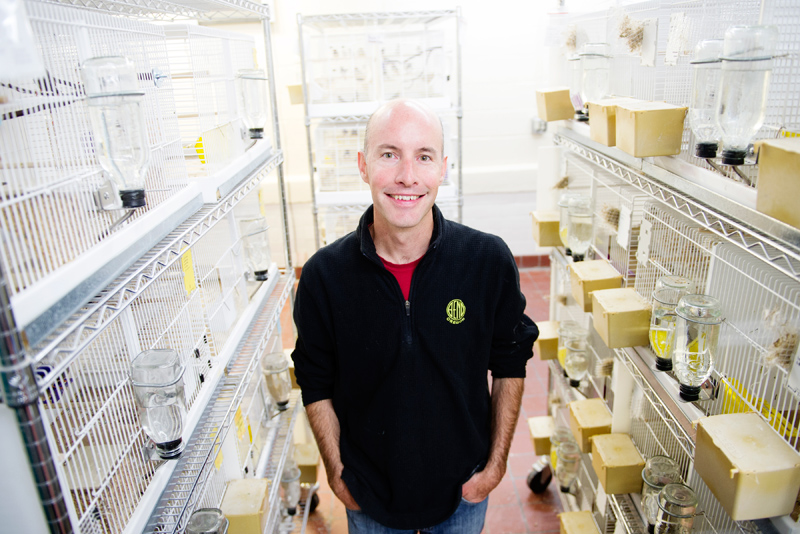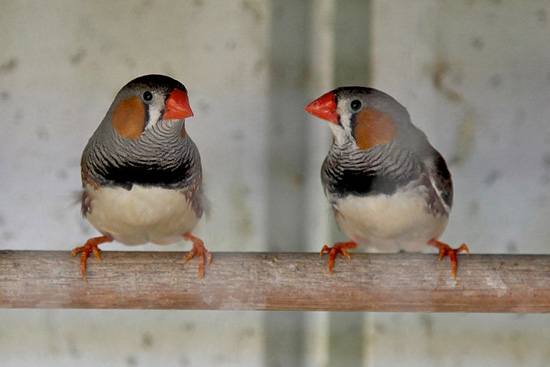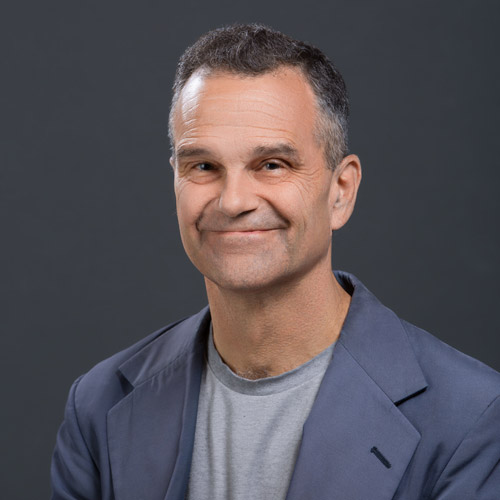Could Bird Brains Lead to Human Cures?
New technology lets BU researcher eavesdrop on avian brains

The anesthetized zebra finch slumbers peacefully on a lab table, a tiny feathered bundle save for the top of its head, which sports a fleshy oval from which feathers, skin, and bone have been peeled back. (Alert: no birds were harmed in the making of this experiment.) In fact, for the next year or two after this surgery, Tim Gardner and his lab assistants will monitor the finch as it fulfills a primal urge: to sing.
The operation will implant in the finch’s brain Lilliputian carbon fiber electrodes invented by Gardner, a Boston University College of Arts & Sciences assistant professor of biology. What will happen next can be seen in a cage against the back wall. There, another finch with electrodes already implanted hops to and fro with a wire trailing out of its head and into a nearby console. A screen displays the spiking of the brain neurons that control the finch’s song.
This is not a birdwatcher’s hobby: the readings tell Gardner how specific neuron types are activated as the finch runs through its repertoire. The technology enabling this glimpse inside another species’ mind is also contributing to the development of treatments for debilitating conditions in humans, possibly including amyotrophic lateral sclerosis (ALS, or Lou Gehrig’s disease), Parkinson’s disease, rheumatoid arthritis, and even asthma and infertility.
Finches “are just driven to sing, even if they’re alone,” says Gardner, who also holds an appointment at the BU College of Engineering and recently won a three-year Innovation Career Development Professorship, given by BU to assistant professors doing promising work towards future licensed technology. “We’re eavesdropping on the brain as they sing, but they’re doing all the hard work. They put in hundreds or thousands of hours practicing to produce this song stably.”
Until now, monitoring the brains of these feathered maestros has been impeded by the existing clunky electrodes that break blood vessels, damaging tissue and inducing the birds’ immune system to reject the implants. Gardner has been using his miniaturized invention—he’s seeking a patent—to research finches’ brains for three years. No more than a centimeter long, the carbon fibers are four microns in diameter; 16 bundled together resemble a bit of beard stubble.
Electrodes this small can be implanted without the birds’ bodies rejecting them; Gardner’s lab has been recording some individual finches’ brain waves for a year or two. Therein lies the potential for helping humans: the electrodes are small enough to also go into visceral nerves the size of a human hair (Gardner’s lab has implanted 16 electrodes into such nerves). Pharmaceutical companies are researching such so-called electroceuticals to stimulate nerves and restore bodily function in patients with diseases that can respond to nerve stimulation. Some companies are trying to develop therapies based on Gardner’s technology.

Microelectrodes have been around for decades, but “to be effective in all of these domains, electrodes really need to be miniaturized,” Gardner says. The challenge has been that such tiny fibers are not stiff enough to implant, and no one had succeeded in implanting arrays of multiple fibers. “We’ve spent many hundreds of hours manipulating these small fibers,” Gardner says, before discovering that dipping the fibers into water and removing them caused them to cling together, similar to a wet paintbrush’s bristles. Once dry, the clustered carbon strands are stiff enough to implant, yet they splay open when inserted in the brain and don’t break through blood vessels.
What they reveal is no less than the working of a zebra finch’s mind. “As they sing, they’re always trying to improve their songs,” Gardner says. “That’s a process that we want to understand in detail—how birds maintain their songs through trial-and-error learning.” Typically, the lab monitors a bird for a week or so, then takes new readings a year or two later, plugging the bird into the brain-scanning machinery via a connector that’s left on its skull. With such checkups over time, the researchers study the cellular basis of memory stability and motor skill maintenance.
Gardner says that the electrodes’ ability to continue working over a long period could mean, among other things, that ALS patients “could receive brain implants to control cursors and gain access to the world,” communicating via computers as the renowned physicist Stephen Hawking, who suffers from ALS, does. “A real tragedy of existing technologies is that they often stop functioning after a period of a month or two,” Gardner says, “and this is clearly related to the large, stiff structure of existing electrodes.” His work, funded by the National Institutes of Health and its BRAIN Initiative, gave Gardner’s lab funds to develop stimulating electrodes based on these small fibers.
Gardner originally studied physics, segueing into biology out of personal as well as scientific interest. A decade ago, “as I was deciding whether or not to do postdoc work in bird song–related neuroscience, my mother-in-law was diagnosed with ALS. And I remember really thinking that I had the skills to make an impact on that kind of field, but I was intellectually very drawn towards this other field of basic neurobiology and sensory vocal learning” in birds. “I remember it being a very difficult decision. I felt like, if I followed my passion, I wasn’t going to end up building devices for treating ALS.” As it turned out, both interests merged in his current research. (His mother-in-law has a slow progressing version of the disease and “is doing well in many respects,” Gardner says.)
The potential crossover of Gardner’s work into alleviating human suffering is one reason that the Office of the Provost chose him for the Innovation Career Development Professorship.
“As a global research university, it is inspiring each day to see the embrace of innovation and the development of exciting ideas into impactful, commercially viable solutions,” says Jean Morrison, University provost. “The translational research Professor Gardner is performing in capturing the neural recordings of animals represents a major technological advance in systems neuroscience and shows what is possible through ingenuity and incredibly hard work.”

Comments & Discussion
Boston University moderates comments to facilitate an informed, substantive, civil conversation. Abusive, profane, self-promotional, misleading, incoherent or off-topic comments will be rejected. Moderators are staffed during regular business hours (EST) and can only accept comments written in English. Statistics or facts must include a citation or a link to the citation.